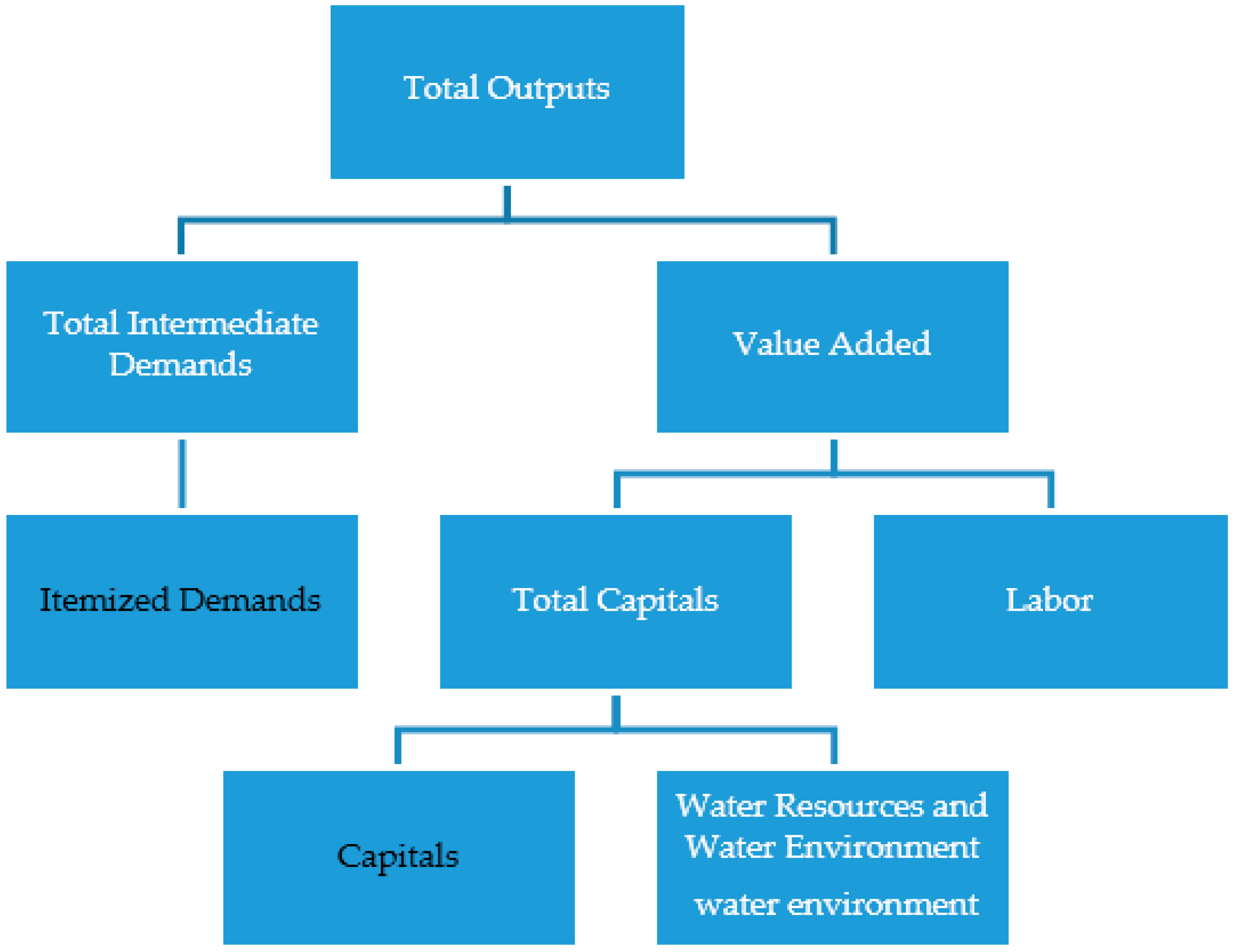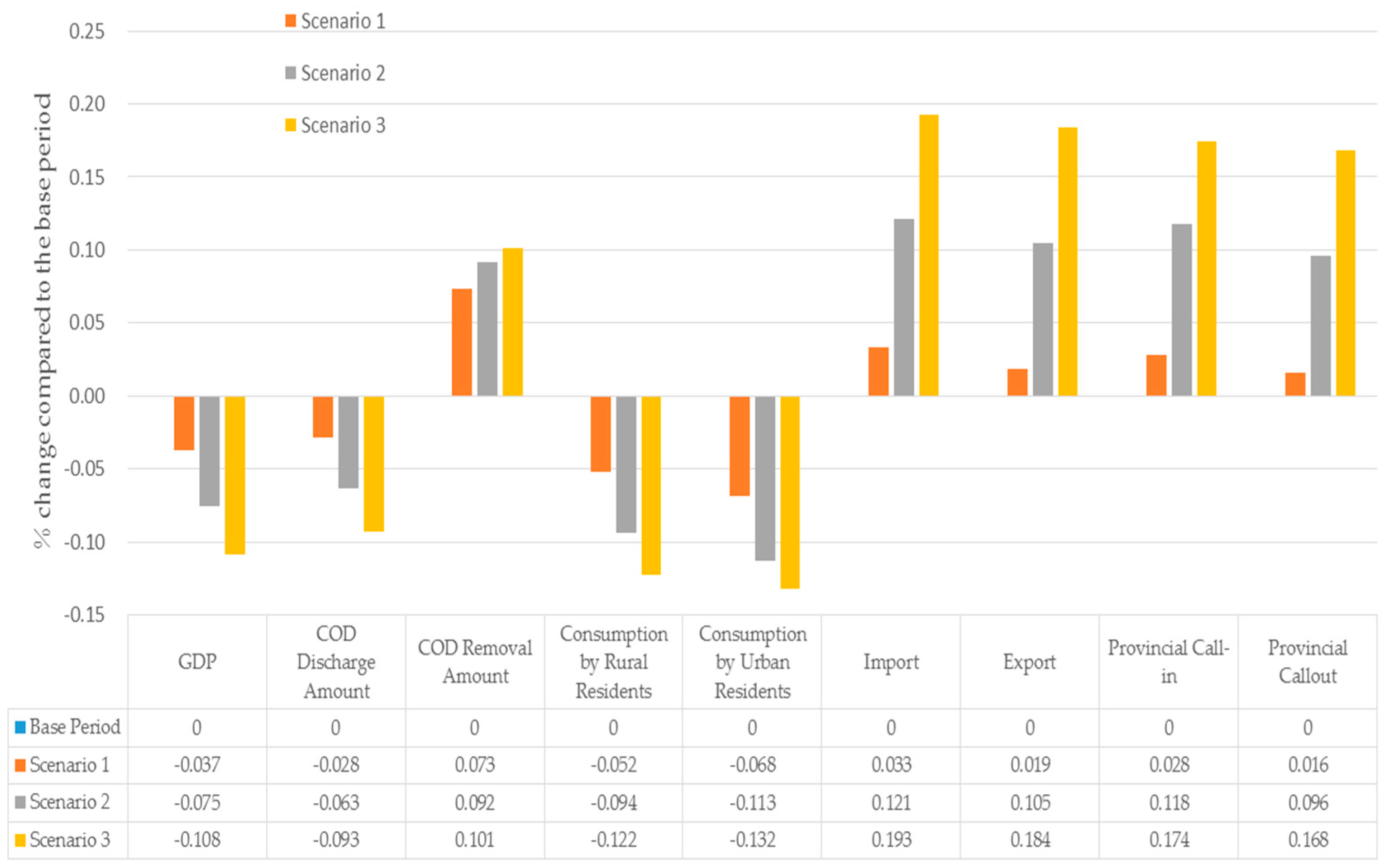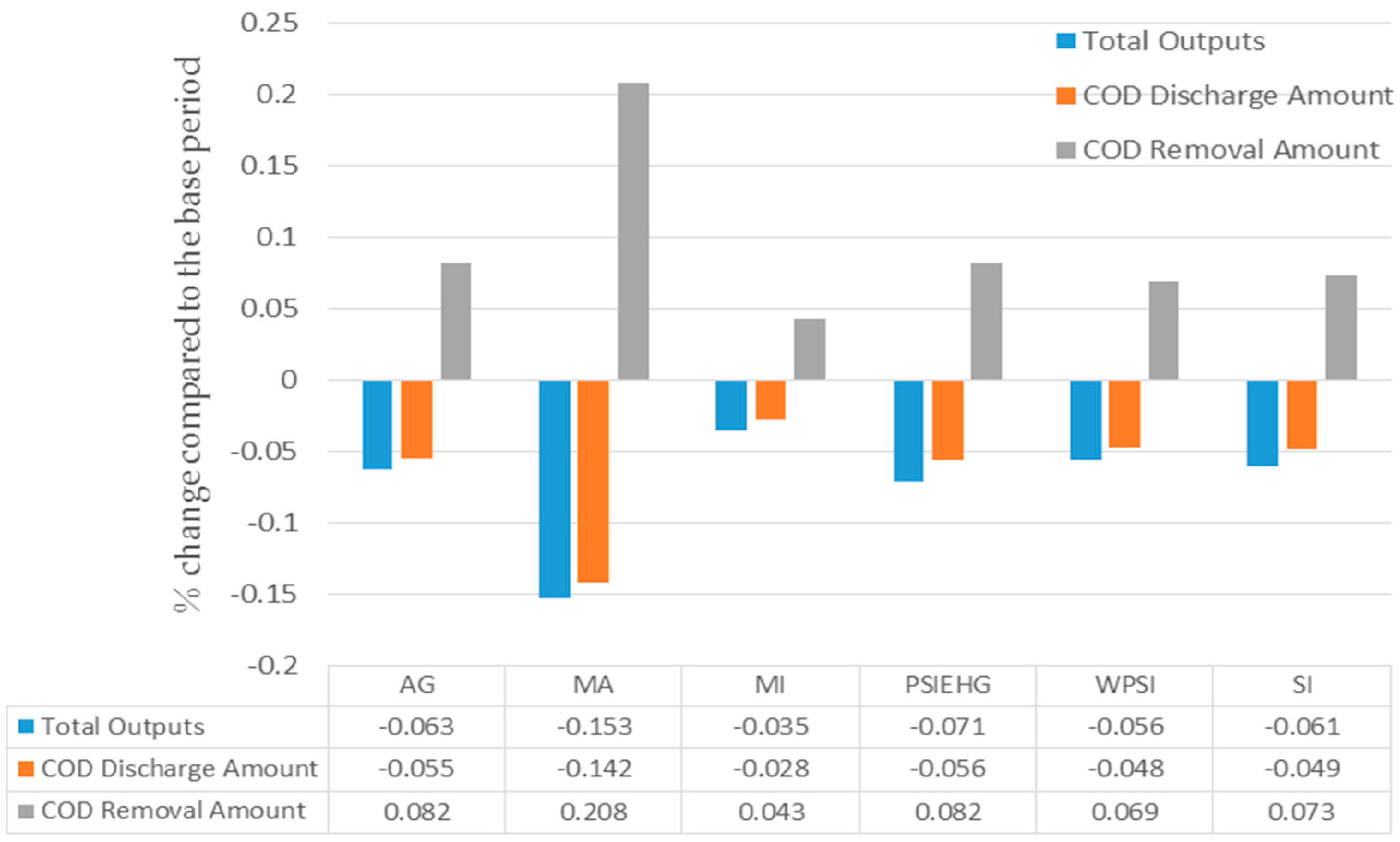Discharge Fee Policy Analysis: A Computable General Equilibrium (CGE) Model of Water Resources and Water Environments
Abstract
:1. Introduction
2. Materials and Methods
2.1. Study Area
2.2. Data Collection
2.3. Extension of Traditional SAM
1. Account of water pollution treatment sector (WPTS)
2. Account of water resources management sector (WRMS)
3. Account of water service of farming, forestry, animal husbandry and fishery (WSFFAHF)
4. Account of water production and supply industry (WPSI)
5. The industrial sectors of the existing national economy in the SAM (AG, MI, MA, PSIEHG, SI)
6. Account of water resources and water environment factors (WRWE)
2.4. Description of the CGE Model
1. COD discharge and COD removal module
2. Production module
3. Trade module
4. Final demand module
5. Factor equilibrium module
6. Macro-closure module
2.5. Parameter Determination
1. The parameters of CES function, CET function and Armington assumption
2. The parameters of LES demand function
2.6. Simulating Impacts of the Discharge Fees
3. Results and Discussion
3.1. Impacts on the Overall Economy
3.2. Impacts on Different Industries
4. Conclusions
Acknowledgments
Author Contributions
Conflicts of Interest
Appendix A
Appendix A.1. COD Discharge and COD Removal Module
Appendix A.1.1. COD Discharge
Appendix A.1.2. COD Removal
Appendix A.2. Production Module
Appendix A.2.1. The First Layer Nested
Appendix A.2.2. The Second Layer Nested
Appendix A.2.3. The Third Layer Nested
Appendix A.3. Trade Module
Appendix A.4. Final Demand Module
Appendix A.4.1. The Residents’ Demands
Appendix A.4.2. The Government’s Demands
Appendix A.4.3. The Other Final Demands
Appendix A.5. Factor Equilibrium Module
Appendix A.6. Macro-Closure Module
References
- Zhao, Y.; Wang, J.F. CGE Model and Application of Economic Analysis; China Economic Publishing House: Beijing, China, 2008. (In Chinese) [Google Scholar]
- Gao, Y. The development method and implementation review of environmental CGE model. Shanghai Environ. Sci. 2008, 27, 210–213. (In Chinese) [Google Scholar]
- Bergman, L. Energy policy modeling: A survey of general equilibrium approaches. J. Policy Model. 1998, 10, 377–399. [Google Scholar] [CrossRef]
- Piggot, J.; Walley, J.; Wigle, R. International Linkages and Carbon Reduction Initiatives. In The Greening of World Trade Issues; Anderson, K., Blackhurst, R., Eds.; The University of Michigan Press: Ann Arbor, MI, USA, 1992; pp. 29–115. [Google Scholar]
- Llop, M.; Ponce-Alifonso, X. Water and agriculture in mediterranean region: The search for a sustainable water policy strategy. Water 2016, 8, 66. [Google Scholar] [CrossRef]
- Robinson, S. Macroeconomics, financial variables and computable general equilibrium models. World Dev. 1991, 19, 1509–1525. [Google Scholar] [CrossRef]
- Nestor, D.V.; Pasurka, C.A. CGE model of pollution abatement process for assessing the economics effects of environmental policy. Econ. Model. 1994, 12, 53–59. [Google Scholar] [CrossRef]
- Seung, C.K.; Harris, T.R.; MacDiarmid, T.R. Economic impact of surface water reallocation policies: A comparison of supply-determined SAM and CGE models. J. Reg. Anal. Policy 1997, 27, 55–76. [Google Scholar]
- Seung, C.K.; Harris, T.R.; MacDiarmid, T.R. Economic impacts of water reallocation: A CGE analysis for walker river basin of Nevada and California. J. Reg. Anal. Policy 1998, 28, 13–34. [Google Scholar]
- Seung, C.K.; Harris, T.R.; Englin, J.E.Y.; Noelwah, R.N. Impacts of water reallocation: A combined computable general equilibrium and recreation demand model approach. Ann. Reg. Sci. 2000, 34, 473–487. [Google Scholar] [CrossRef]
- Robinson, S.; Gueneau, A. CGE-W: An Integrated Modeling Framework for Analyzing Water-Economy Links Applied to Pakistan. In Proceedings of the 16th Annual Conference on Global Economic Analysis, Shanghai, China, 12–14 June 2013.
- Decaluwé, B.; Patry, A.; Savard, L. When water is no longer heaven sent: Comparative pricing analysis in a CGE model. Cah. Trav. 1999, 99, 5. [Google Scholar]
- Decaluwé, B.; Patry, A.; Savard, L.; Thorbecke, E. Poverty Analysis within a General Equilibrium Framework; Working Paper 9909; African Economic Research Consortium: Nairobi, Kenya, 1999; pp. 3–43. [Google Scholar]
- Gómez, C.M.; Tirado, D.; Rey-Maquieira, J. Water exchanges versus water works: Insights from a computable general equilibrium model for the Balearic Islands. Water Resour. Res. 2004, 40, W10502. [Google Scholar] [CrossRef]
- Hatano, T.; Okuda, T. Water Resource Allocation In the Yellow River Basin, China Applying A CGE Model. In Proceedings of the Intermediate Input-Output Conference, Sendai, Japan, 26–28 July 2006.
- Cardenete, M.A.; Hewings, G.J.D. Water price and water reallocation in Andalusia: A computable general equilibrium approach. Environ. Econ. 2011, 2, 17–27. [Google Scholar]
- Watson, P.S.; Davies, S. Modeling the effects of population growth on water resources: A CGE analysis of the South Platte River Basin in Colorado. Ann. Reg. Sci. 2011, 46, 331–348. [Google Scholar] [CrossRef]
- Qin, C.; Jia, Y.; Su, Z.; Bressers, H.T.A.; Wang, H. The economic impact of water tax charges in China: A static computable general equilibrium analysis. Water Int. 2012, 37, 279–292. [Google Scholar] [CrossRef]
- Boccanfuso, D.; Estache, A.; Savard, L. A Poverty Inequality Assessment of Liberalization of Water Utility in Senegal: A Macro-Micro Analysis, Cahier de Recherché/Working Paper; unpublished work. 2005.
- Letsoalo, A.; Blignaut, J.; de Wet, T.; de Wit, M.; Hess, S.; Tol, R.S.J.; Van Heerden, J. Triple dividends of water consumption charges in South Africa. Water Resour. Res. 2007, 43. [Google Scholar] [CrossRef]
- Luckmann, J.; Grethe, H.; McDonald, S.; Orlov, A.; Siddig, K. An integrated economic model of multiple types and uses of water. Water Resour. Res. 2014, 50, 3875–3892. [Google Scholar] [CrossRef]
- Environmental Protection Department of Jiangsu Province. Available online: http://www.jshb.gov.cn/jshbw/hbzl/ndhjzkgb/201306/t20130605_236653.html (accessed on 5 June 2013). (In Chinese)
- Jiangsu Provincial Bureau of Statistics. 2012 Input-Output Table of Jiangsu; Jiangsu Provincial Bureau of Statistics: Nanjing, China, 2012. [Google Scholar]
- Jiangsu Provincial Bureau of Statistics. 2013. Available online: http://www.jssb.gov.cn/2013nj/indexc.htm (accessed on 20 April 2015). (In Chinese)
- Major Targets for National Economic and Social Development of Jiangsu Province. 2012. Available online: http://www.jssb.gov.cn/tjxxgk/tjsj/ndsj/201504/t20150420_259211.html (accessed on 20 April 2015). (In Chinese)
- Huo, Y.B. The Study on CSI Model Constructing & GME Integration Evaluating of Its Parameter. Ph.D. Thesis, Nanjing University of Science & Technology, Nanjing, China, 9 September 2004. [Google Scholar]
- Wang, L. Armington Elasticity Estimation in the Main Industry in Our Country—Based on State-Space Model. Master’s Thesis, Shanghai Academy of Social Sciences, Shanghai, China, 2013. [Google Scholar]
- Valipour, M. Future of the area equipped for irrigation. Arch. Agron. Soil Sci. 2014, 60, 1641–1660. [Google Scholar] [CrossRef]
- Valipour, M. Future of agricultural water management in Africa. Arch. Agron. Soil Sci. 2015, 61, 907–927. [Google Scholar] [CrossRef]
- Valipour, M. A comprehensive study on irrigation management in Asia and Oceania. Arch. Agron. Soil Sci. 2015, 61, 1247–1271. [Google Scholar] [CrossRef]
- Pérez Blanco, C.D.; Thaler, T. An input-output assessment of water productivity in the Castile and León Region (Spain). Water 2014, 6, 929–944. [Google Scholar] [CrossRef]



| Unit: 100 Million Yuan RMB | Commodity | Activity | ||||||||||
|---|---|---|---|---|---|---|---|---|---|---|---|---|
| WRMS | AG | WSFFAHF | MI | MA | PSIEHG | WPSI | SI | WPTS | WRMS | |||
| Commodity | WRMS | 0 | ||||||||||
| AG | 0.01 | |||||||||||
| WSFFAHF | 0 | |||||||||||
| MI | 0.05 | |||||||||||
| MA | 1.07 | |||||||||||
| PSIEHG | 0.16 | |||||||||||
| WPSI | 0.01 | |||||||||||
| SI | 1.53 | |||||||||||
| WPTS | 0 | |||||||||||
| Activity | WRMS | 6.045 | 0 | 0 | 0 | 0 | 0 | 0 | 0 | 0 | ||
| AG | 0 | 2992.78 | 0 | 0 | 0 | 0 | 0 | 0 | 0 | |||
| WSFFAHF | 0 | 0 | 71.94 | 0 | 0 | 0 | 0 | 0 | 0 | |||
| MI | 0 | 0 | 0 | 419.56 | 0 | 0 | 0 | 0 | 0 | |||
| MA | 0 | 0 | 0 | 0 | 56951.33 | 0 | 0 | 0 | 0 | |||
| PSIEHG | 0 | 0 | 0 | 0 | 0 | 2295.02 | 0 | 0 | 0 | |||
| WPSI | 0 | 0 | 0 | 0 | 0 | 0 | 61.91 | 0 | 0 | |||
| SI | 0 | 0 | 0 | 0 | 0 | 0 | 0 | 20728.22 | 0 | |||
| WPTS | 0 | 0 | 0 | 0 | 0 | 0 | 0 | 0 | 22.89 | |||
| Factor | Labor | 1.36 | ||||||||||
| Capital | 1.82 | |||||||||||
| WRWE | 0 | |||||||||||
| Resident | Rural | |||||||||||
| Urban | ||||||||||||
| Enterprise | ||||||||||||
| Government | Local | 0 | 104.82 | 0 | 186.74 | 1498.22 | 0 | 0 | 35.91 | 0 | ||
| Central | 0.03 | |||||||||||
| Abroad | 0 | 593.96 | 0 | 911.73 | 7314.83 | 0 | 0 | 203.48 | ||||
| Other Regions | 0 | 369.17 | 0 | 1689.15 | 7756.57 | 263.79 | 0 | 1280.42 | ||||
| FCF | ||||||||||||
| SNC | ||||||||||||
| Unit: 100 Million Yuan RMB | Activity | Factor | ||||||||||
| AG | WSFFAHF | MI | MA | PSIEHG | WPSI | SI | WPTS | Labor | Capital | WRWE | ||
| Commodity | WRMS | 0 | 2.66 | 0 | 0 | 0 | 3.39 | 0 | 0 | |||
| AG | 296.88 | 9.71 | 1.39 | 2107.75 | 0.05 | 0 | 205.82 | 0.24 | ||||
| WSFFAHF | 71.94 | 0 | 0 | 0 | 0 | 0 | 0 | 0 | ||||
| MI | 2.00 | 0.05 | 38.01 | 2654.22 | 34.81 | 0.21 | 94.31 | 0.17 | ||||
| MA | 656.91 | 11.01 | 124.01 | 33308.19 | 39.47 | 9.75 | 574.84 | 6.10 | ||||
| PSIEHG | 10.11 | 0.77 | 33.02 | 1308.33 | 72.93 | 10.79 | 213.42 | 0.36 | ||||
| WPSI | 0.31 | 0.73 | 0.48 | 29.15 | 2.54 | 1.22 | 10.92 | 0.02 | ||||
| SI | 178.01 | 8.07 | 54.39 | 4508.92 | 23.29 | 8.07 | 358.64 | 3.67 | ||||
| WPTS | 1.56 | 0.02 | 1.10 | 4.90 | 0.33 | 0.02 | 5.05 | 0.01 | ||||
| Activity | WRMS | |||||||||||
| AG | ||||||||||||
| WSFFAHF | ||||||||||||
| MI | ||||||||||||
| MA | ||||||||||||
| PSIEHG | ||||||||||||
| WPSI | ||||||||||||
| SI | ||||||||||||
| WPTS | ||||||||||||
| Factor | Labor | 168.48 | 37.64 | 72.30 | 4123.87 | 10.35 | 12.70 | 420.26 | 7.36 | |||
| Capital | 88.62 | 1.96 | 53.55 | 6076.53 | 34.46 | 11.90 | 502.70 | 4.83 | ||||
| WRWE | 0.31 | 0.01 | 0.59 | 66.65 | 3.78 | 0.04 | 5.14 | 0.02 | ||||
| Resident | Rural | 226.25 | 164.05 | |||||||||
| Urban | 798.37 | 111.29 | ||||||||||
| Enterprise | 883.45 | 126.15 | ||||||||||
| Government | Local | 0 | 0 | 12.54 | 534.33 | 43.44 | 1.38 | 789.84 | 0.01 | |||
| Central | 0 | 0 | 28.17 | 2228.49 | 91.83 | 2.51 | 789.33 | 0.13 | ||||
| Abroad | ||||||||||||
| Other Regions | ||||||||||||
| FCF | 0 | |||||||||||
| SNC | ||||||||||||
| Unit: 100 Million Yuan RMB | Resident | Enterprise | Government | Exports | Provincial Callout | Capital Account | ||||||
| Rural | Urban | Local | Central | FCF | SNC | |||||||
| Commodity | WRMS | 0 | 0 | 0 | 0 | 0 | 0 | 0 | 0 | |||
| AG | 454.46 | 523.02 | 30.10 | 8.55 | 21.06 | 329.18 | 70.41 | 2.11 | ||||
| WSFFAHF | 0 | 0 | 0 | 0 | 0 | 0 | 0 | 0 | ||||
| MI | 7.31 | 4.59 | 0 | 0 | 0.01 | 49.51 | 0 | 8.68 | ||||
| MA | 688.46 | 1867.80 | 0 | 0 | 132.38 | 11381.37 | 5377.14 | 70.77 | ||||
| PSIEHG | 66.69 | 99.85 | 0 | 0 | 0 | 85.19 | 0 | 0.89 | ||||
| WPSI | 4.32 | 30.53 | 0 | 0 | 0 | 0 | 0 | 7.67 | ||||
| SI | 855.62 | 2715.87 | 2523.63 | 716.54 | 249.07 | 724.46 | 5849.00 | 31.87 | ||||
| WPTS | 2.00 | 9.50 | 0 | 0 | 0 | 0 | 0 | 0 | ||||
| Activity | WRMS | |||||||||||
| AG | ||||||||||||
| WSFFAHF | ||||||||||||
| MI | ||||||||||||
| MA | ||||||||||||
| PSIEHG | ||||||||||||
| WPSI | ||||||||||||
| SI | ||||||||||||
| WPTS | ||||||||||||
| Factor | Labor | |||||||||||
| Capital | ||||||||||||
| WRWE | ||||||||||||
| Resident | Rural | 60.64 | ||||||||||
| Urban | 1896.71 | 214.00 | ||||||||||
| Enterprise | ||||||||||||
| Government | Local | 22.19 | 88.76 | 221.51 | 535.84 | |||||||
| Central | 33.29 | 133.14 | 353.59 | 130.13 | ||||||||
| Abroad | ||||||||||||
| Other Regions | ||||||||||||
| FCF | 1829.27 | 5744.27 | 6511.70 | 1117.32 | 253.265 | −448.45 | −1210.60 | |||||
| SNC | 743.59 | |||||||||||
| Sector Para. | WRMS | AG | WSFFAHF | MI | MA | PSIEHG | WPSI | SI | WPTS |
|---|---|---|---|---|---|---|---|---|---|
| 0.1907 | 0.3230 | 0.3230 | 0.1886 | 0.7573 | 0.3234 | 0.3234 | 0.1907 | 0.1907 | |
| 3 | 3 | 3 | 3 | 3 | 3 | 3 | 3 | 3 | |
| 1.9 | 2.2 | 2.2 | 2.8 | 2.8 | 2.8 | 2.8 | 1.9 | 1.9 |
| Sector | Rural Residents | Urban Residents | ||
|---|---|---|---|---|
| Basic Demand (Million Yuan RMB) | Marginal Budget Share | Basic Demand (Million Yuan RMB) | Marginal Budget Share | |
| WRMS | 0 | 0 | ||
| AG | 6946.4 | 0.407 | 26,390.7 | 0.109 |
| WSFFAHF | 0 | 0 | ||
| MI | 15.2 | 0.008 | 390.3 | 0.0003 |
| MA | 46,748.1 | 0.234 | 135,267.1 | 0.216 |
| PSIEHG | 571.9 | 0.065 | 7819.9 | 0.009 |
| WPSI | 194.1 | 0.003 | 1481.9 | 0.002 |
| SI | 58,779.3 | 0.283 | 114,041.4 | 0.661 |
| WPTS | 137.4 | 0.001 | 398.9 | 0.002 |
© 2016 by the authors; licensee MDPI, Basel, Switzerland. This article is an open access article distributed under the terms and conditions of the Creative Commons Attribution (CC-BY) license (http://creativecommons.org/licenses/by/4.0/).
Share and Cite
Fang, G.; Wang, T.; Si, X.; Wen, X.; Liu, Y. Discharge Fee Policy Analysis: A Computable General Equilibrium (CGE) Model of Water Resources and Water Environments. Water 2016, 8, 413. https://doi.org/10.3390/w8090413
Fang G, Wang T, Si X, Wen X, Liu Y. Discharge Fee Policy Analysis: A Computable General Equilibrium (CGE) Model of Water Resources and Water Environments. Water. 2016; 8(9):413. https://doi.org/10.3390/w8090413
Chicago/Turabian StyleFang, Guohua, Ting Wang, Xinyi Si, Xin Wen, and Yu Liu. 2016. "Discharge Fee Policy Analysis: A Computable General Equilibrium (CGE) Model of Water Resources and Water Environments" Water 8, no. 9: 413. https://doi.org/10.3390/w8090413





